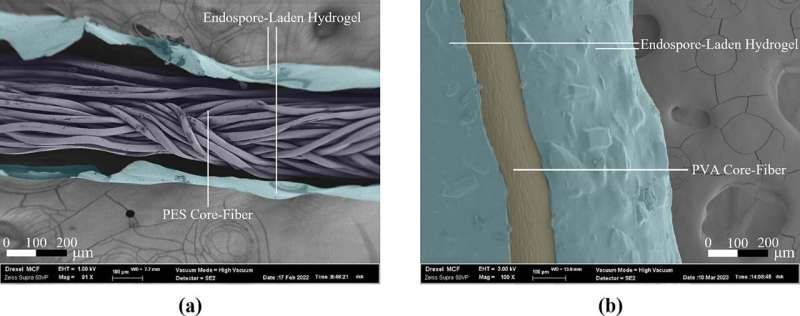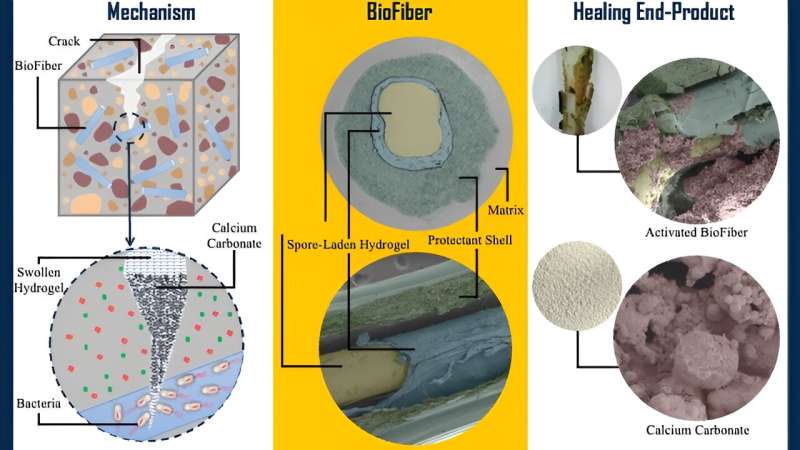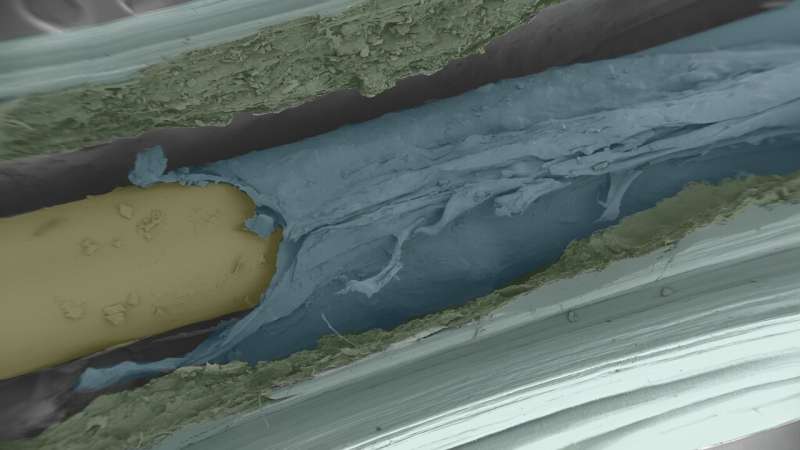
In hopes of producing concrete structures that can repair their cracks, researchers from Drexel University’s College of Engineering are putting a new twist on an old trick for improving the durability of concrete.
Fiber reinforcement has been around since the first masons mixed horsehair into their mud. However the Drexel research team is taking this method to the next level by turning reinforcing fibers into a living tissue system that rushes concrete-healing bacteria to the site of cracks to repair the damage.
Recently reported in the journal Construction and Building Materials, Drexel’s “BioFiber” is a polymer fiber encased in a bacteria-laden hydrogel and a protective, damage-responsive shell. The team reports that a grid of BioFibers embedded within a concrete structure can improve its durability, prevent cracks from growing, and enable self-healing.
“This is an exciting development for the ongoing efforts to improve building materials using inspiration from nature,” said Amir Farnam, Ph.D., an associate professor in the College of Engineering who was a leader of the research team.
“We are seeing every day that our aging concrete structures are experiencing damage, which lowers their functional life and requires critical repairs that are costly. Imagine they can heal themselves? In our skin, our tissue does it naturally through a multilayer fibrous structure infused with our self-healing fluid—blood. These biofibers mimic this concept and use stone-making bacteria to create damage-responsive living self-healing concrete.”
Lengthening the lifespan of concrete is not just a benefit for the building sector, it’s become a priority for countries around the world that are working to reduce greenhouse gas. The process of making the ingredients of concrete—burning a mixture of minerals, such as limestone, clay, or shale at temperatures in excess of 2,000 degrees Fahrenheit—accounts for 8% of global greenhouse gas emissions.
Concrete structures can degrade in as little as 50 years, depending on their environment. Between replacements and the growing demand for new buildings, concrete is the most consumed and most in-demand building material in the world.
Producing concrete that can last longer would be a big step in reducing its contribution to global warming, not to mention reducing the long-term cost of infrastructure repairs, which is why the U.S. Department of Energy has recently launched efforts focused on improving it.

Over the last decade, Drexel has led the way in looking at how to improve concrete’s sustainability and durability, and Farnam’s lab is part of a team participating in a Department of Defense effort to fortify its aging structures.
“For several years, the concept of bio-self-healing cementitious composites has been nurtured within the Advanced Infrastructure Materials Lab,” said Mohammad Houshmand, a doctoral candidate in Farnam’s lab who was the lead author of the research.
“The BioFiber project represents a collaborative, multidisciplinary endeavor, integrating expertise from the fields of civil engineering, biology, chemistry, and materials science. The primary objective is to pioneer developing a multifunctional self-healing BioFiber technology, setting new standards at the intersection of these diverse disciplines.”
The team’s approach to creating BioFibers was inspired by skin tissue’s self-healing capability and the vasculature system’s role in helping organisms heal their own wounds. It uses a biological technique they developed to enable self-repairing in concrete infrastructure with the help of biomineralizing bacteria.
In collaboration with research teams led by Caroline Schauer, Ph.D., the Margaret C. Burns Chair in Engineering, Christopher Sales, Ph.D., an associate professor, and Ahmad Najafi, Ph.D., an assistant professor, all from the College of Engineering, the group identified a strain of Lysinibacillus sphaericus bacteria as a bio-healing agent for the fiber.
The durable bacteria, typically found in the soil, has the ability to drive a biological process called microbial-induced calcium carbonate precipitation to create a stone-like material that can stabilize and harden into a patch for exposed cracks in concrete.
When induced into forming an endospore, the bacteria can survive the harsh conditions inside the concrete, lying dormant until called into action.

“One of the amazing things about this research is how everyone comes at the problem from their different expertise, and the solutions to creating novel BioFibers are so much stronger because of that,” Schauer said.
“Selecting the right combination of bacteria, hydrogel, and polymer coating was central to this research and to the functionality of BioFiber. Drawing inspiration from nature is one thing, but translating that into an application comprised of biological ingredients that can all coexist in a functional structure is quite an undertaking—one that required a multifaced team of experts to successfully achieve.”
To assemble the BioFiber, the team started with a polymer fiber core capable of stabilizing and supporting concrete structures. It coated the fiber with a layer of endospore-laden hydrogel and encased the entire assembly with a damage-responsive polymer shell, like skin tissues. The entire assembly is a little over half a millimeter thick.
Placed in a grid throughout the concrete as it is poured, the BioFiber acts as a reinforcing support agent. But its true talents are revealed only when a crack penetrates the concrete enough to pierce the fiber’s outer polymer shell.
As water makes its way into the crack, eventually reaching the BioFiber, it causes the hydrogel to expand and push its way out of the shell and up toward the surface of the crack. While this happens, the bacteria are activated from their endospore form in the presence of carbon and a nutrient source in the concrete. Reacting with the calcium in the concrete, the bacteria produce calcium carbonate, which acts as a cementing material to fill the crack all the way to the surface.
The healing time ultimately depends on the size of the crack and activity of the bacteria—a mechanism the team is currently studying—but early indications suggest the bacteria could do its job in as little as one to two days.
“While there is much work to be done in examining the kinetics of self-repair, our findings suggest that this is a viable method for arresting formation, stabilizing and repairing cracks without external intervention,” Farnam said. “This means that BioFiber could one day be used to make a ‘living’ concrete infrastructure and extend its life, preventing the need for costly repairs or replacements.”
More information:
Mohammad Houshmand Khaneghahi et al, Development of a nature-inspired polymeric fiber (BioFiber) for advanced delivery of self-healing agents into concrete, Construction and Building Materials (2023). DOI: 10.1016/j.conbuildmat.2023.133765
Citation:
Veins of bacteria could form a self-healing system for concrete infrastructure (2023, December 8)
retrieved 10 December 2023
from https://techxplore.com/news/2023-12-veins-bacteria-self-healing-concrete-infrastructure.html
This document is subject to copyright. Apart from any fair dealing for the purpose of private study or research, no
part may be reproduced without the written permission. The content is provided for information purposes only.
For all the latest Technology News Click Here
For the latest news and updates, follow us on Google News.
